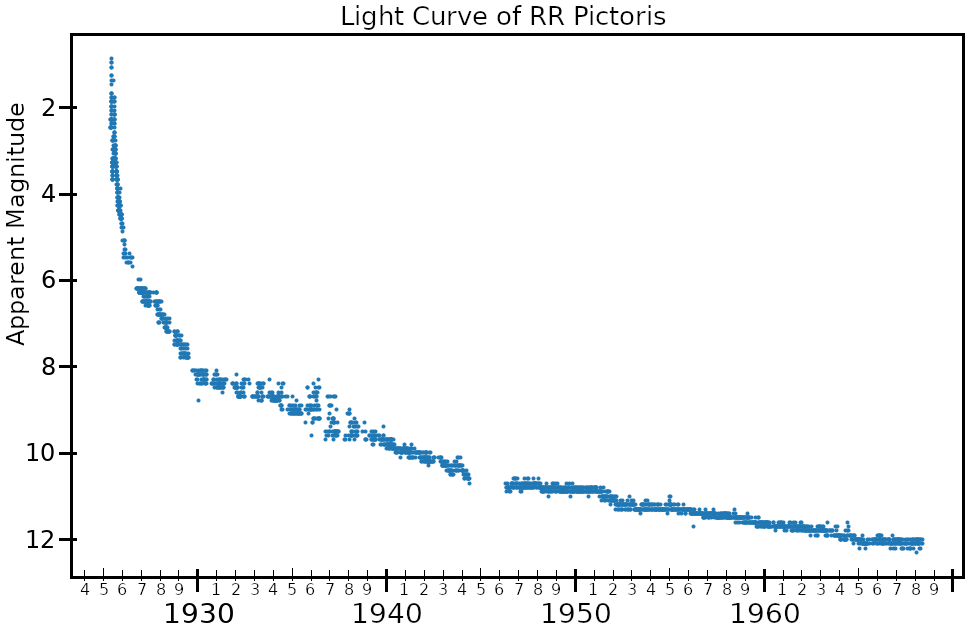RR Pictoris on:
[Wikipedia]
[Google]
[Amazon]

 RR Pictoris, also known as Nova Pictoris 1925, is a cataclysmic variable star system that flared up as a
RR Pictoris, also known as Nova Pictoris 1925, is a cataclysmic variable star system that flared up as a
"New Star May Hold Clue to Solar Puzzle," ''Milwaukee Sentinel'', February 1, 1944, Final Edition, page 1
{{DEFAULTSORT:RR Pictoris Novae Pictor 1925 in science Pictoris, RR 031481 Nova remnants

 RR Pictoris, also known as Nova Pictoris 1925, is a cataclysmic variable star system that flared up as a
RR Pictoris, also known as Nova Pictoris 1925, is a cataclysmic variable star system that flared up as a nova
A nova ( novae or novas) is a transient astronomical event that causes the sudden appearance of a bright, apparently "new" star (hence the name "nova", Latin for "new") that slowly fades over weeks or months. All observed novae involve white ...
that lit up in the constellation Pictor in 1925. It was discovered by South African amateur astronomer Robert Watson who lived in Beaufort West. At 05:50 AM on 25 May 1925, Mr. Watson was walking to work and noticed a star that he did not recognize in line with the stars α Crucis
Acrux is the brightest star in the southern constellation of Crux. It has the Bayer designation α Crucis, which is Latinisation of names, Latinised to Alpha Crucis and abbreviated Alpha Cru or α Cru. With a combined visual magnitude o ...
and β Carinae. He consulted his copy of Norton's Star Atlas, and realized that the unfamiliar star was a nova. Fortuitously, Mr. Watson was employed as a telegraph operator, and he promptly sent a telegram describing his discovery to the Royal Observatory at Cape Town. This quick reporting of the event allowed southern observatories to obtain spectra of the nova before it had reached maximum brightness.
At the time of its discovery, RR Pictoris had an apparent magnitude
Apparent magnitude () is a measure of the Irradiance, brightness of a star, astronomical object or other celestial objects like artificial satellites. Its value depends on its intrinsic luminosity, its distance, and any extinction (astronomy), ...
of 2.3. It continued to brighten to magnitude 1.2, which it reached on 9 June 1925. It dimmed to magnitude 4 by 4 July, but brightened again to 1.9 on 9 August. Six months after its peak brightness, RR Pictoris faded to be invisible to the unaided eye, and was magnitude 12.5 by 1975. RR Pictoris is classified as a slow nova and its light curve exhibits positive superhumps, meaning superhumps with a period a few percent (8.6% in this case) longer than the star system's orbital period.
Measurements by the Gaia spacecraft show that the RR Pictoris system is around 510 parsecs (1670 light-years) from the Earth.
Novae are close binary systems composed of a white dwarf
A white dwarf is a Compact star, stellar core remnant composed mostly of electron-degenerate matter. A white dwarf is very density, dense: in an Earth sized volume, it packs a mass that is comparable to the Sun. No nuclear fusion takes place i ...
and secondary star that is so close it is filling up its Roche lobe
In astronomy, the Roche lobe is the region around a star in a binary system within which orbiting material is gravitationally bound to that star. It is an approximately teardrop-shaped region bounded by a critical gravitational equipotential, ...
with stellar material, which is then transferred onto the first star's accretion disc
An accretion disk is a structure (often a circumstellar disk) formed by diffuse material in orbital motion around a massive central body. The central body is most frequently a star. Friction, uneven irradiance, magnetohydrodynamic effects, and ...
. Once this material reaches a critical mass, it ignites and the system brightens tremendously. The two stars of RR Pictoris orbit each other every 3.48 hours. Calculations of the speed suggest the secondary star is not dense enough for its size to still be on the main sequence
In astronomy, the main sequence is a classification of stars which appear on plots of stellar color index, color versus absolute magnitude, brightness as a continuous and distinctive band. Stars on this band are known as main-sequence stars or d ...
, so it itself must have begun expanding and cooling already as its core has run out of hydrogen fuel.
Small variations in the observed orbital period suggest that RR Pictoris system may include a low mass (0.25 M⊙) third star orbiting the close binary pair with a period of about 70 years.
A small (< 30 arc second) filamentary nebula surrounds the nova, and comparisons of images taken several years apart have allowed its rate of expansion to be measured.
References
External links
"New Star May Hold Clue to Solar Puzzle," ''Milwaukee Sentinel'', February 1, 1944, Final Edition, page 1
{{DEFAULTSORT:RR Pictoris Novae Pictor 1925 in science Pictoris, RR 031481 Nova remnants